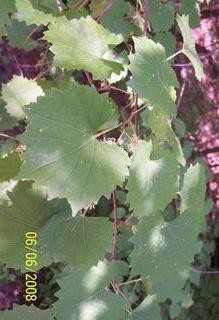Mustang grape
(Vitis mustangensis)

Description
Vitis mustangensis, commonly known as the mustang grape, is a species of grape that is native to the southern United States. Its range includes parts of Mississippi, Alabama, Louisiana, Texas, and Oklahoma. This woody species produces small clusters of hard green fruit that ripen into soft 3⁄4-inch (2 cm) dark purple berries between July –September. They have a thick outer layer of flesh and on average contain four heart-shaped seeds. This variety of grape is recognized by the leaves that have a white velvet-like underside and lobed, cordate shape. These vines often cover trees, shrubs, fences and other objects that it grows near. V. mustangensis is dioecious, with only female vines bearing fruit. The fruit can be potentially irritating to the skin when handled, and are mildly unpleasant to eat raw because of bitterness and a high acidity content. This grape has a list of culinary use as jelly, pie-filling, wine and grape juice, all of which are typically processed with heat and sweetened with sugar. Mustang grapes have been used to make mustang wine since before the Civil War. The fruit and leaves of Mustang Grapes may also be used to dye wool. Vitis (grapevines) is a genus of 79 accepted species of vining plants in the flowering plant family Vitaceae. The genus is made up of species predominantly from the Northern Hemisphere. It is economically important as the source of grapes, both for direct consumption of the fruit and for fermentation to produce wine. The study and cultivation of grapevines is called viticulture. Most cultivated Vitis varieties are wind-pollinated with hermaphroditic flowers containing both male and female reproductive structures, while wild species are dieceous. These flowers are grouped in bunches called inflorescences. In many species, such as Vitis vinifera, each successfully pollinated flower becomes a grape berry with the inflorescence turning into a cluster of grapes. While the flowers of the grapevines are usually very small, the berries are often large and brightly colored with sweet flavors that attract birds and other animals to disperse the seeds contained within the berries. Grapevines usually only produce fruit on shoots that came from buds that were developed during the previous growing season.
Taxonomic tree:







